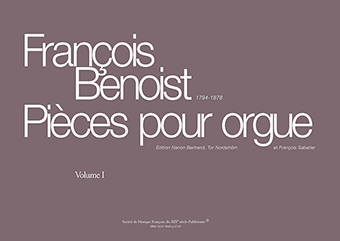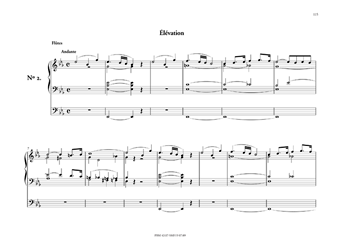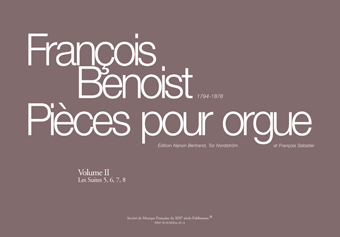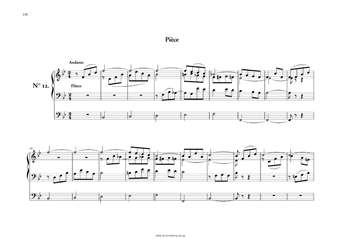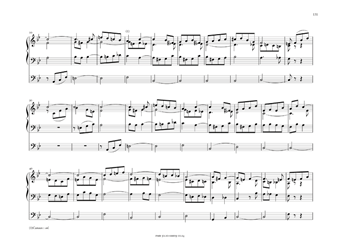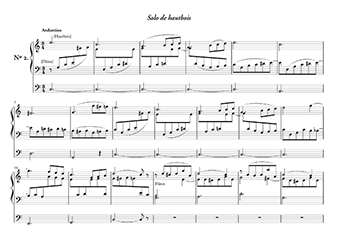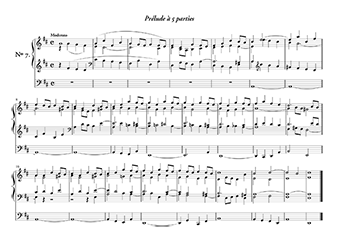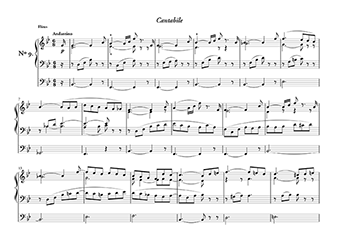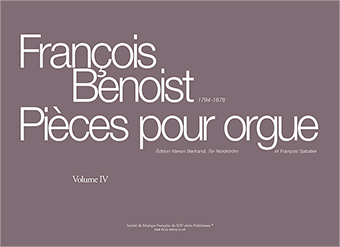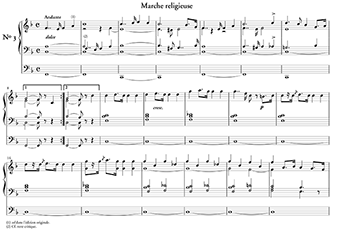Composer's Catalogue
François BENOIST
(1794-1878)
Benoist
Pièces pour Orgue
Volume I
Bibliothèque de l'Organiste
Suites 1, 2, 3, 4Ref. PBM 43.07-SMF19 07.09
↓Benoist
Pièces pour Orgue
Volume II
Bibliothèque de l'Organiste
Suites 5, 6, 7, 8Ref. PBM 50.10-SMF19 09.15
↓Benoist
Pièces pour Orgue
Volume III
Bibliothèque de l'Organiste,
ou Suites de Pièces pour l'OrgueRef. PBM 53.11-SMF19 11.17
↓Benoist
Pièces pour Orgue
Volume IV
Pièces diversesRef. PBM 61.15-SMF19 15.26
↓
2nd edition
Complete works for Organ (4-volume)
François Benoist
Pièces pour Orgue
Volume I
Bibliothèque de l'Organiste
Suites 1, 2, 3, 4
Ref. PBM 43.07-SMF19 07.09
Technical info
A volume 310 x 225 (landscape format). 134-page. Edition N. Bertrand, T. Nordström and F. Sabatier. Presentation in French, English.
Offertoires 1-7, Grands Chœurs 1-2, Élévations 1-4
Contents
Bibliothèque de l'organiste. Suite n° 1: Offertoire n° 1 in C major; Offertoire n° 2 in F major; Grand Chœur n° 1 in E minor.
Suite n° 2: Offertoire n° 3 in B b major; Offertoire n° 4 in C major; Grand Chœur n° 2 in C major.
Suite n° 3: Offertoire n° 5 in E b major; Offertoire n° 6 in F major.
Suite n° 4: Élévation n° 1 in D major; Offertoire n° 7 in C major; Élévation n° 2 in E b major; Élévation n° 3 in B b major; Élévation n° 4 in G major.
Summary
François Benoist was a musician who, thanks to his versatility, exerted an influence of French musical life from the late 1820s to the mid-1860s. As a composer, he produced not only church music but also works for the stage. His posts as court organist and professor of the organ at the Paris Conservatory during an exceptionally long period (1819-1872 at the Conservatory) placed him in an unique position in comparison with other organists in Paris. He and A-P-F Boëly were often mentioned together by the critics as “the two excellent exemplars” or representatives for “the good school”.
Volume I of this second edition was made after the two available sources: Bibliothèque nationale and Conservatoire. It contains the Suites 1-4 from Bibliothèque de l'organiste ou Suites de Pièces pour l'orgue, now presenting them in their right order.
François Benoist
Pièces pour Orgue
Volume II
Bibliothèque de l'Organiste
Suites 5, 6, 7, 8
Ref. PBM 50.10-SMF19 09.15
Technical info
A volume 310 x 225 (landscape format). 140-page. Edition N. Bertrand, T. Nordström and F. Sabatier. Presentation in French, English.
Offertoires 8-9, Pièces 1-12, Élévations (4), Grand Chœur, Introduction, Sortie, Rentrée de procession (2)
Contents
Bibliothèque de l'organiste. Suite n° 5. Pièces de différents caractères (1841) : Pièce n° 1 en ut majeur; Élévation n° 5 en ut majeur; Élévation n° 6 en ut majeur; Pièce n° 2 en ut majeur; Pièce n° 3 en sol majeur; Pièce n° 4 en sol majeur; Grand Chœur en ré majeur.
Suite n° 6 (1842) : Pièce n° 5 en sol majeur; Pièce n° 6 en sol; Pièce n° 7 en fa majeur; Pièce n° 8 en ut; Pièce n° 9 en ré majeur; Pièce n° 10 en si b majeur; Introduction n° 11 en sol majeur.
Suite n° 7 : Offertoire n° 8 en ut; Offertoire n° 9 en ré majeur.
Suite n° 8 (1859) : Rentrée de procession en mi b majeur; Élévation n° 5 en ut majeur; Rentrée de procession en sol majeur; Élévation n° 6 en ré majeur; Sortie en fa majeur; Pièce n° 12 en si b majeur.
Summary
It may be impossible to fix Benoist's élévations and character pieces to a certain instrument but one thing is sure: the idea of the expressive organ is present in his music. The great offertoires and grands chœurs ask for an organ with even up to five manuals. In the offertoires of grand chœur character known from the first Suites, Benoist strictly uses indications of manuals in order to indicate dynamic changes, then he gives up that old praxis in favour of another, introduced in the Élévations of the 4th Suite, using all kinds of dynamic marks: pp, ff, sf, fp, etc.
François Benoist
Pièces pour Orgue
Volume III
Bibliothèque de l'Organiste,
ou Suites de Pièces pour l'Orgue
Suites 9, 10, 11, 12
Ref. PBM 53.11-SMF19 11.17
Technical info
A volume 310 x 225 (landscape format). 142-page. Edition N. Bertrand, T. Nordström and F. Sabatier. Presentation in French and English.
Préludes, Rentrées de procession, Offertoires, Communions, Versets, Prières, Sortie, pièces diverses.
Contents
Suite n° 9 (1860): Rentrée de procession in C major; Solo for Oboe in C major; Moderato sempre legato in C major; Communion in F major; Rentrée de procession in G major; Verse in G major; Sortie in A major; Offertory in A major.
Suite n° 10 (1860): First Prelude in C minor; Second Prelude in C major; First Verse in C minor; Second Verse in C major; Duo in C minor; Offertory in C major; Prelude for 5 voices in D major; Andante in D major; Short Verse in D minor; Prelude in G minor; Amen in E b major; Communion in E b minor; Trio in E b major.
Suite n° 11 (1861): Communion in F major; Prayer in F major; Communion in F major; Verse in F major; Verse in G major; Prayer in G major; Offertory in G minor/major; Duo in G major.
Suite n° 12 (1861): Prelude in D mineur; 1st Verse in D; 2nd Verse in D; 3rd Verse in D minor; Communion in E b major; Prelude in F major; Communion in F major; Verse in G major; Cantabile in B b major; Prelude in C major; Communion in C major.
Summary
In the musical texture, we can observe the ability of Benoist to combine a homophonic and polyphonic method as well as his imaginative way of developing seemingly poor motifs. His frequent modulations are often third-oriented and, on the whole, enharmonic changes with common tones and chromatic glides play an important part ion the harmonic development. It is not uncommon for sequential episodes to contain features from Baroque music.
In contrast to Lefébure-Wely that mostly uses a strictly realized sonata form, Benoist uses a free monothematic form.
François Benoist
Pièces pour Orgue
Volume IV
Pièces diverses
Ref. PBM 61.15-SMF19 15.26
Technical info
A volume 310 x 225 (landscape format). 60-page. Edition N. Bertrand, T. Nordström and F. Sabatier. Presentation in French and English.
Contents
La Maîtrise: Prière in E b major — Fac simile: Andante (Prière), arrangement by W.T. Best — Marche religieuse in C major — Premier Prélude in F major — Second Prélude in G major.
L'Athénée musical: Prière in E b major.
Répertoire de musique religieuse pour orgue ou orgue expressif: Offertoire in D major.
Recueil de 4 Morceaux pour orgue: 1. Andante in A minor/major — 2. Fugue sur le chant de Pange lingua in D — 3. Marche religieuse in F major — 4. Communion in G major.
Les Maîtres français de l'Orgue aux XVIe, XVIIe et XVIIIe siècles: Three Anthems. 1. Kyrie “orbis factor” (Chant in the Bass) — 2. Kyrie “orbis factor” (Chant in the Soprano) — 3. Ave maris stella.
Summary
The present volume contains later individual pieces. They are presented in chronological order of publication. As such — and in the absence of other pieces which may have escaped our investigation — the four volumes contain the complete organ works of François Benoist, indications for the execution of which can also be found in Volume 1, which also gives details of the instruments played by Benoist as well as contemporary registration practice.
The pieces reproduced here, from the most substantial compositions to the shortest verses, confirm all the points that we made concerning form, style and language. One will remember that Benoist makes use of a wide tonal palette and system of modulation which, it has already been observed, could have had a beneficial effect on Franck.
Without attaining the genius of Franck, the works of François Benoist bear witness to an appreciable sense of propriety and attention to detail that could not be applied to all French organists of the period.
Reviews
François Benoist
Pièces pour Orgue
Volume I
Ref. PBM 26.96 /// OUT OF ORDER
“When the Benoist' compositions are not at the same level as those by his student C. Franck, they however reveal how he had a thorough knowledge of his job. The Publimuses publication is clear, both the presentation and the editorial notes are concise but comprehensive. All the sources are given.”
(T. van Eck, KDOV [Nederlands], January 1997)
“The organists will appreciate discovering the works by the Franck's teacher. Imposing for the most, they are in an original style and plenty modulations, and they are the sign of a ‘reliable’ composer. There are about 200 pages of music and a thorough preface.”
(Guy Bovet, La Tribune de l’orgue no. 4, December 1996)
“Thanks to F. Sabatier and N. Bertrand for their excellent job, more especially as it is accompanied by irreproachable editorial notes. This beautiful edition, legibly engraved, might please the organists who bother to play everytime the same pieces.”
(E. Kocevar, L’Orgue no. 240, 4th quarter 1996)
“Many organists wondered what the music composed by F. Benoist (organ teacher at the Conservatoire de Paris from 1819 to 1872!) looks like. Thanks to the editor to have published this elegant score including 30 pieces, numerous editorial notes, and clearly engraved.”
(J. Ferrard, Magazine de l’orgue, no. 29, June 1996)
François Benoist
Pièces pour Orgue
Volume II
Ref. PBM 29.99 /// OUT OF ORDER
“I already had the opportunity to introduce in this magazine that new parisian publisher, Publimuses, which has specialized in the publication (and re-publication) of the French 19th century repertoire. For those who appreciate that repertoire’s ‘perfume’, Publimuses brings out here the complete works by Benoist.
“In the Benoist’s writing, who is using widely the modulations, one can observe the influences on Franck. The pieces included in this second volume are clearly designated for a litugical purpose, though several of them, being very long, are rather for the concert.
“The engraving and the layout are especially attractive.”
(A. Macinanti, Arte oraganaria e organistica, no. 29, September-October 1999)

